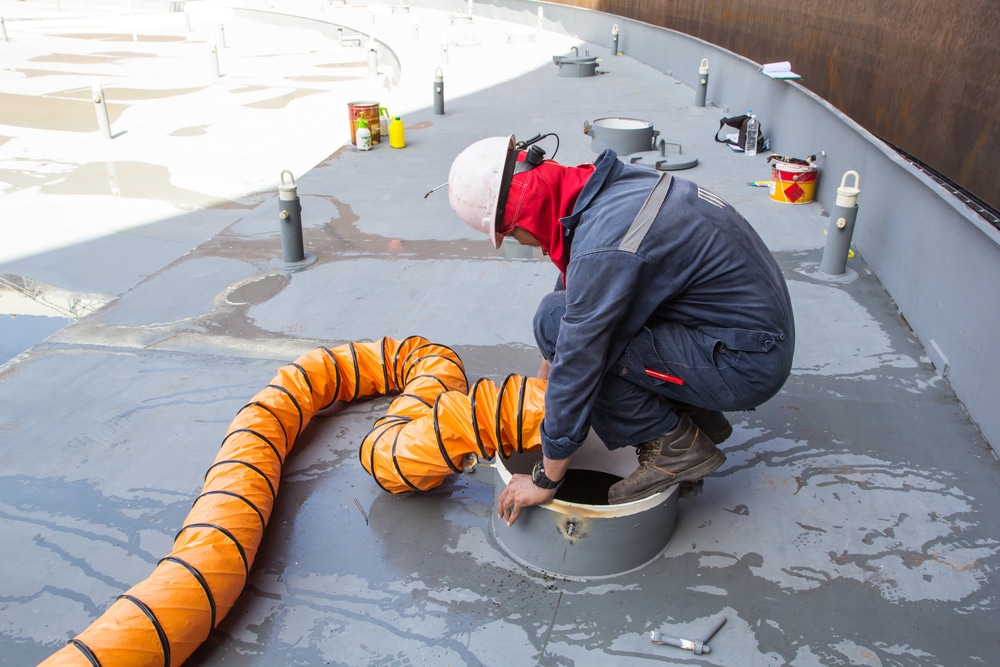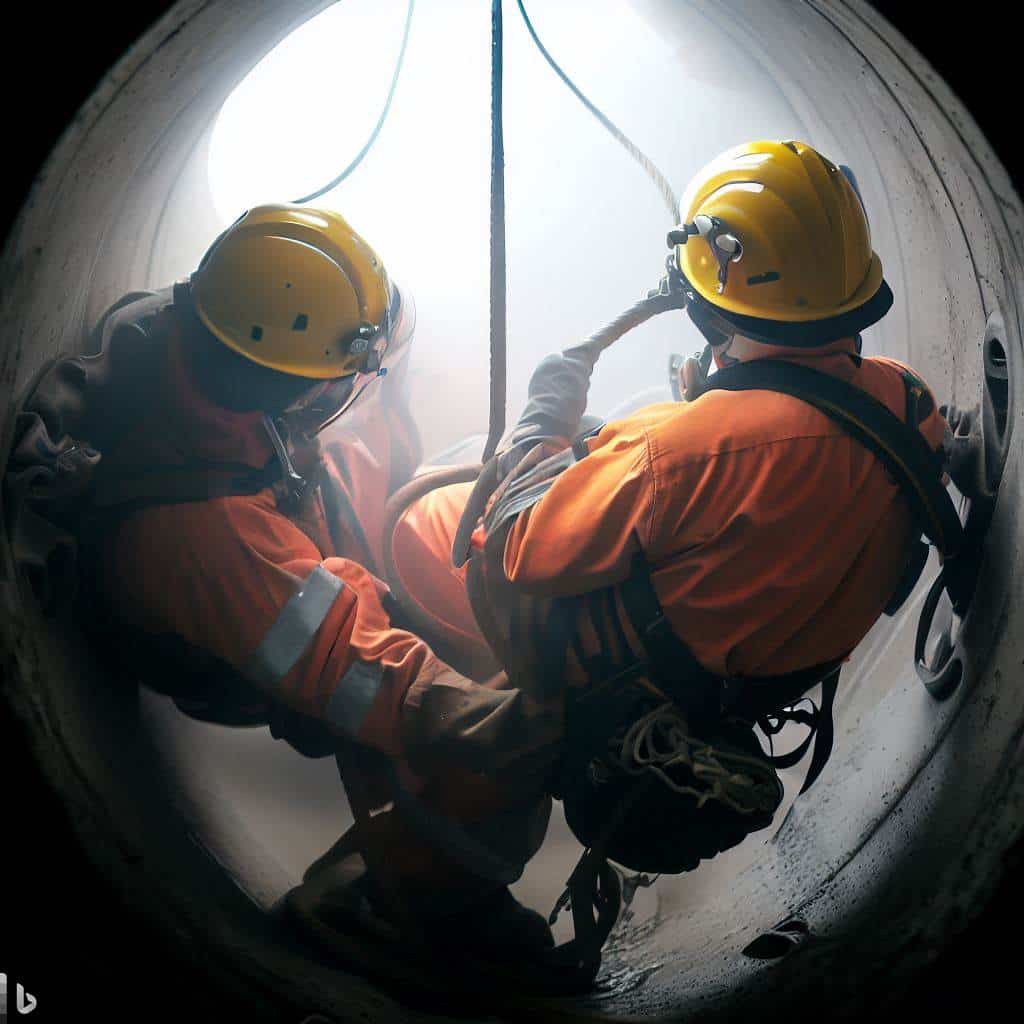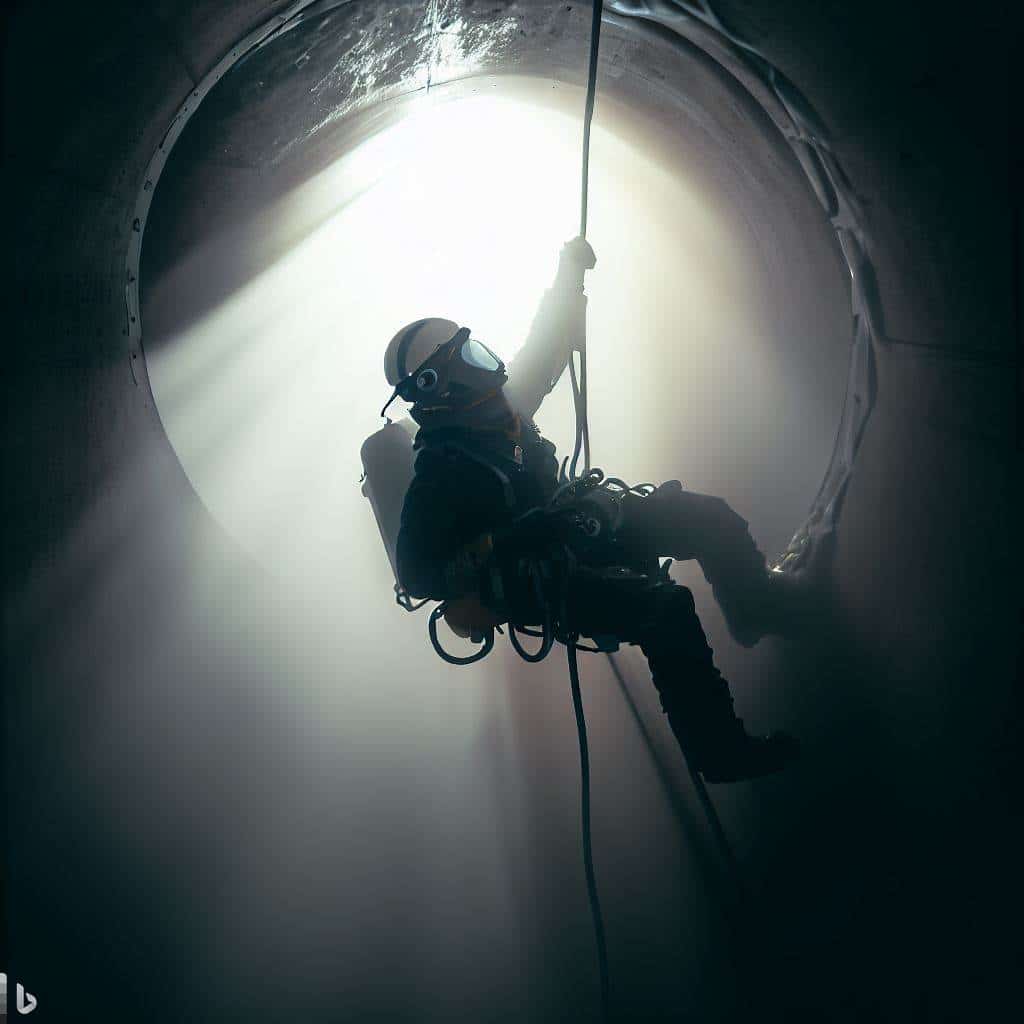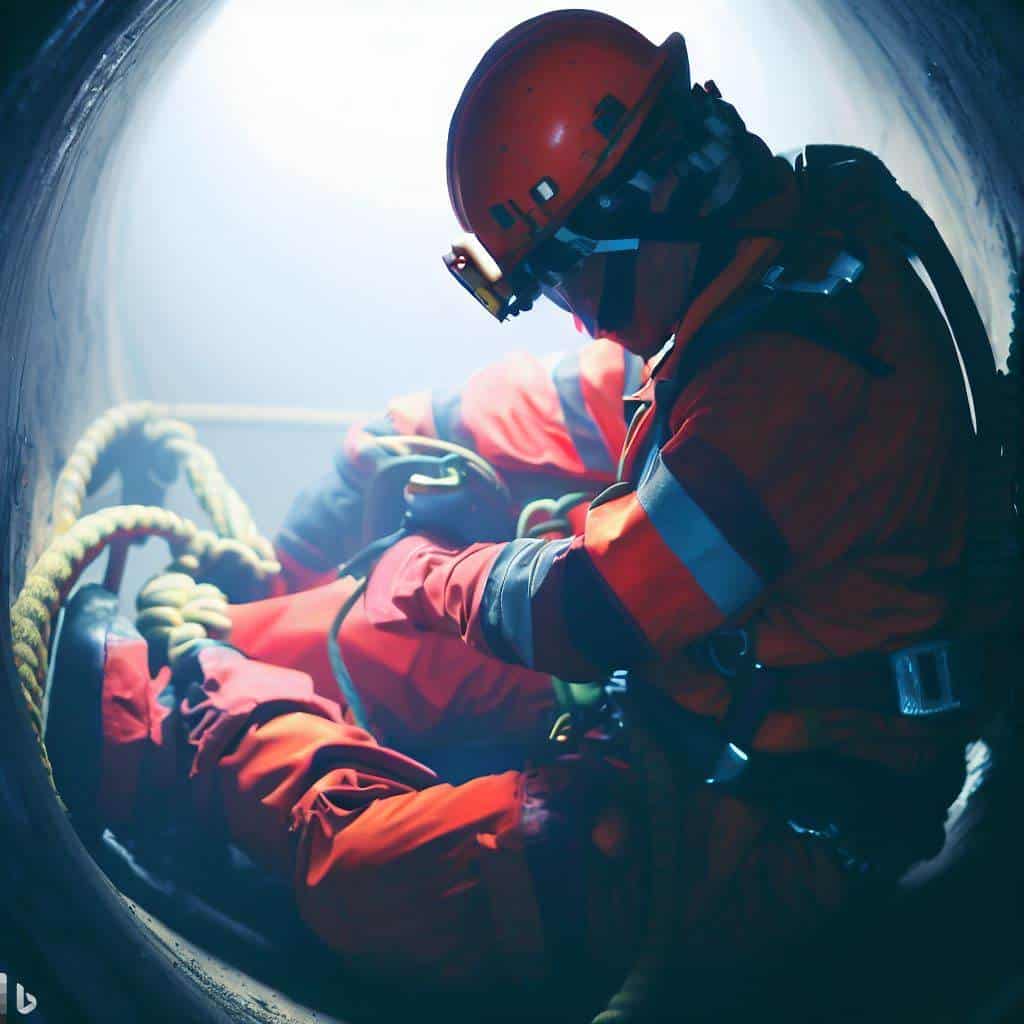Confined Space Rescue Plan – [Updated for 2023]

Job sites with confined spaces present uniquely dangerous conditions – especially if those spaces are difficult to enter or exit or if they contain hazardous materials or energy sources.
OSHA has strict confined space rescue plan requirements in place for all companies working in permit-required confined spaces. However, not everyone is authorized or qualified to perform confined space rescue. All personnel designated to the rescue team must be rigorously trained on the company’s specific confined space rescue plan to ensure the rescue system operation is executed properly.
Data from the CDC shows that most confined space deaths – at least 60% – are would-be rescuers rather than victims of the original incident. Without proper planning and frequent drills to ensure everyone knows what to do, even the simplest-seeming rescue operation can end in tragedy.
Keep reading for a full rundown of the appropriate rescue procedures related to extracting stranded workers from confined spaces. We also offer a full training course on confined space.
Common Types of Confined Spaces
There are several specific confined spaces workers may need to enter as part of their jobs. Some of the most common include:
- Utility tunnels
- Basements and crawl spaces
- Storage tanks
- Manholes
Working in or around any of these areas necessitates a strong confined space rescue plan, an established and highly-trained rescue team, and all the rescue equipment pertinent to the type of confined space involved.

Dangers of Working in a Confined Space
Confined space work presents numerous hazards that threaten workers’ health and safety. Failure to take these dangers into account is one of the primary reasons some rescue efforts result in tragedy.
Limited Exits
Many confined spaces – such as manholes, shafts, and utility tunnels – have limited access points. Rescuers need to plan how they will enter and exit such areas before enacting a rescue plan in order to avoid becoming trapped themselves.
Flooding
Confined space water rescues present a host of unique challenges. Rescue teams need to be prepared to execute the plan in a timely manner to prevent drowning.
Most water rescues require lifting equipment, and it takes considerable effort to pull a person out of the water.
Structurally Unsound Walls or Ceiling
If the confined space has structural weaknesses like an unsound ceiling or walls, the team must take great care to avoid a collapse. Even minor debris falling from high enough up can cause significant head trauma and other injuries.
Toxic Gases
Most confined spaces have poor ventilation, and many involve the presence of toxic or flammable gases. Prolonged exposure to these hazards can cause permanent breathing issues and other serious health problems.
Rescue plans in environments with dangerous gases must include wearing a self-contained breathing apparatus and other personal protective equipment.
Hazardous Energy Sources
Often, employees in a confined space need to handle or work in the vicinity of potentially dangerous energy sources.
Some of the most common include:
- Electrical energy
- Chemical feed lines
- Natural gas
- Steam
- Methane
- Inert gas
Confined spaces also trap heat, which can be dangerous to worker health and necessitates immediate action.

Essential Elements of an Effective Confined Space Rescue Plan
A company’s rescue capabilities are only as good as its plan and the knowledge and training of its authorized team.
These are the steps a rescue team must follow in order to come up with and carry out a successful confined space rescue solution for any given scenario.
1. Hold Regular Confined Space Rescue Drills
Structuring and codifying a plan is only the first step in protecting worker safety. It’s absolutely vital for the designated team to conduct rescue drills in order to hone their skills and ensure a smooth operation in the event of a real emergency.
Rescue drills provide personnel with the confidence and team-building necessary to execute all stages of the company’s plan without hesitation or costly mistakes.
After the initial training, drills should be held periodically to ensure all team members are clear on their duties.
2. Determine the Confined Space Rescue Requirements
Confined space rescues fall within one of two categories: time-sensitive and non-time-sensitive.
Ideally, all confined space rescue procedures should be executed in a timely manner, particularly if the trapped worker has sustained an injury. However, the rescue effort will follow a different protocol depending on which category the scenario falls under.
A time-sensitive confined space rescue is considered an urgent rescue. In these cases, there are factors at play that requires rescuers to conduct confined space rescue expediently, usually within about six minutes. Time-sensitive rescues typically involve a lack of oxygen within the confined space or another impending threat like rapid flooding.
In a non-time-sensitive confined space rescue, there is no risk to the worker or rescuer air supply, and rescuers may enact the confined space rescue procedure within a much wider window. An example of a common non-time-sensitive scenarios is when a worker falls down a shaft and injures their leg or ankle but is otherwise in no immediate danger.
3. Ensure All Rescue Personnel Wear Proper Rescue Equipment
Rescue personnel must wear proper personal protective equipment (PPE). The type of equipment needed depends on where the emergency occurs. The team’s efforts will be for nothing if the team doesn’t have the proper equipment and rescue team members end up succumbing to the same toxic conditions the trapped worker is experiencing.
In a low- or no-oxygen environment – or if there are toxic gases present within the space – any team member entering the area must wear a self-contained breathing apparatus. Full body harnesses are one of the most common forms of rescue team PPE, especially when a steep descent is involved.
A rescue person wearing proper PPE is much less likely to meet with a catastrophic accident during the operation. Otherwise, the situation may end up with the team designated for the rescue rescuing their teammate along with the initial victim.
The initial training must include sessions on using any relevant PPE, including respirators, gas monitors, rescue boards, harnesses, and descent systems. All equipment should be inspected and tested before each shift.

4. Examine the Confined Space
Confined space assessments help rescuers determine the equipment they’ll need in order to execute the plan. Surveying confined spaces before attempting a rescue is also vital to ensure the team is aware of all potential hazards within the space.
In many cases, hazard control must take precedence over removing the trapped person to ensure everyone’s safety. For instance, hazardous energy isolation may be necessary before rescuing the trapped person if there is a potentially dangerous source of power within the space.
Other reasons to survey confined spaces before entering them include:
- Determining the confined space entry points. If the rescue service requires entering the confined area, rescuers need to know exactly how they’ll get into and out of the space to avoid becoming trapped themselves.
- Judging the space’s dimensions. Is there extra equipment in the area taking up room? Have any walls or parts of the ceiling collapsed? How much room workers have to maneuver can heavily influence the techniques and equipment they’ll be able to use when enacting the rescue plan.
- Confirming the trapped person’s condition. Rescuers need to know whether the person they’re rescuing is injured and requires a stretcher or rescue board upon being freed from the area. If the trapped person is non-responsive, the operation should be enacted as expediently as possible to ensure they get swift care.
Many confined spaces require vertical rescues. The team will need to gauge the space’s depth and the conditions at the bottom of the shaft in order to safely plan and execute the rescue operation.
5. Examine the Confined Space Entry Points
Once the entry and exit points have been located, rescuers must check them for obstructions and potential hazards before commencing with the operation.
Though practice drills are a critical aspect of training, they do not necessarily provide an accurate representation of real-life rescue conditions. Even if teammates have rehearsed entering and exiting the space, the actual circumstances during an emergency operation may necessitate unforeseen adjustments to the plan.
For instance, a stalled machine or large piece of equipment may be partially or entirely blocking an important entrance. Rescuers may not be able to fit the equipment they’ve been trained to use into the space.
Vertical rescues in the chemical industry often make use of a tripod to hoist trapped workers to safety. However, in some cases there isn’t enough room to set up a tripod over the space’s entrance. Rescuers will need to install anchor bolts over the entry points instead.
Determining potential entry or exit limitations allows authorized employees to prepare for conditions that may hamper their efforts, lessening the chance of would-be rescuers sustaining injuries or becoming trapped themselves.
6. Notify External Emergency Response and/or Local Emergency Services
Local emergency response authorities should be informed of the circumstances at the confined space job site before work commences. This step is necessary under OSHA regulations when the job site requires a permit, but it’s a good idea any time employees may be working in or near spaces with limited access and room for movement.
Local authorities need to following information in order to be prepared to execute or assist with a rescue operation:
- The types of confined spaces within the job site, including detailed descriptions of each
- Any hazards that may be present within those spaces
- Locations and descriptions of all access points and entries
- The necessary equipment and PPE to safely enact the rescue plan
Not every local emergency response team is equipped to perform rescue service in confined spaces. The fire department is the best external entity to coordinate with for most job sites, as they are the most likely to have the requisite training and equipment to perform confined space rescues.
7. Establish a Confined Space Rescue Team
Before any work begins within or in the vicinity of a confined space, the company must establish a team of authorized employees who are trained on the proper procedures should a worker become trapped.
This team should be rigorously trained in all matters relevant to rescuing a trapped person, including how to survey the space for hazards, using the relevant PPE, and the best procedures for carrying out the operation.
All personnel should know who is on the team so they know who to contact in the event a worker is trapped in a confined area.
Employees on the rescue team must also be certified in CPR and first aid. If the trapped person is grievously injured, emergency response personnel may not arrive in time to administer the required assistance. Rescuers must also know how to assess each other for symptoms of toxic gas exposure, such as narcosis and hypoxia.
Frequently Asked Questions
A viable confined space rescue plan is the best way to promote and preserve employee safety in potentially hazardous working conditions.
It’s all too easy for even the most experienced worker to become trapped in an enclosed area. Limited mobility, dim light, unscalable walls, and hazardous conditions often render self-rescues from confined spaces challenging or impossible.
Establishing and training a response team to swiftly enact the company’s plan for enclosed area rescues is crucial to ensure a prompt and well-executed operation.
OSHA requires rescue plans for all work occurring in permit-required confined spaces. Job sites with confined spaces that meet any of the following criteria must include contacting emergency services in their rescue strategy:
+ The space is large enough to accommodate at least one worker
+ There is limited ability to enter or exit the space
+ The space isn’t designed or intended to be occupied long-term
The permit must include the following information about the company and the confined space workers will be occupying:
– Confined space identification – Names of the supervisors on duty and the authorized rescue team members, as well as the name and location of each confined area
– Confined space date of occupation – When and how long the work will take place
– Type of work involved – What workers will be doing in the space and the materials and equipment they’ll be using
– Environmental concerns – Air quality, soil testing data, and any possible hazards employees may encounter
OSHA defines the three types of confined space rescues as follows:
1) Non-entry rescue. The rescue can be conducted without rescuers entering the space. This is most common in vertical rescues and is usually performed using a rope or a rescue winch. The category also includes self-rescues.
2) Entry by others. If the company does not have a rescue team prepared, an emergency service such as the Fire Department will assist.
3) Entry by trained employees. If the company has a designated confined space rescue team, they will be designated to execute the company’s established rescue plans.
The seven steps involved in a successful confined space rescue are as follows:
1) Regular drills and thorough training to ensure employee capabilities
2) Confirming the type of rescue needed, whether time-sensitive or non-time-sensitive
3) Distributing and inspecting proper PPE to all rescuers
4) Surveying the confined area’s conditions
5) Checking the exit and entry points for hazardous conditions or obstructions
6) Informing local authorities of the conditions at the job site, especially if the company doesn’t have a designated rescue team and/or the site requires a permit
7) Establishing a rescue team that knows every particular of the rescue plan, is trained in using the requisite PPE, and has run practice drills together to ensure cohesion
The company’s rescue plan should be in place before any work at the job site or within the confined space commences.
Developing and Executing a Confined Space Rescue Plan: Final Thoughts
Many of the on-site deaths associated with working in and around confined areas are preventable. They are largely due to a lack of preparation and awareness on the part of the rescuers.
Without a detailed confined space rescue plan, employees may not know how to protect their own health and safety before leaping to their co-worker’s aid. They are less likely to don the proper PPE or to be able to operate the necessary equipment for conducting successful rescues.
All employers whose workers conduct operations within or in the vicinity of small, enclosed spaces must adopt a company plan for rescuing trapped individuals. The plan should involve emergency services such as the local fire department and emergency medical services. It should also include forming and training a response team to perform rescues when non-entry rescues and entry by others aren’t feasible.
A well-devised confined space rescue plan protects employee health and promotes a safe and efficient work environment.